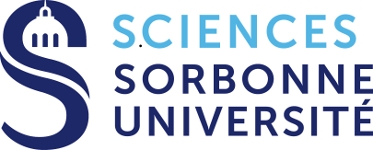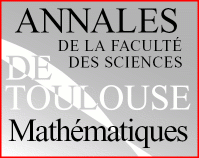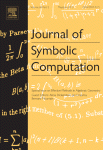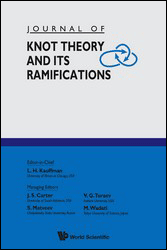
P.-V. Koseleff
Accueil
Enseignement
Publications
Exposés
Cv
Liens
|
Erwan Brugallé, Pierre-Vincent Koseleff, Daniel Pecker The lexicographic degree of the first two-bridge knots 30 p., 58 fig., 6 tables. (2020) |
 |
|
Abstract:
We study the degree of polynomial representations of knots.
We give the lexicographic degree of all two-bridge knots with 11 or fewer crossings.
First, we estimate the total degree of a lexicographic parametrisation of such a knot.
This allows us to transform this problem into a study of real algebraic trigonal plane curves,
and in particular to use the braid theoretical method developed by Orevkov.
| |
|
Koseleff P.-V., Pecker D., Rouillier F., Tran C., Computing Chebyshev knot diagrams, Journal of Symbolic Computation, Elsevier, 2018, 86, pp.21. |
 |
|
Abstract:
A Chebyshev curve $\mathcal{C}(a,b,c,\varphi)$ has a parametrization of the form
$ x(t)=T_a(t)$; \, $y(t)=T_b(t)$; $z(t)= T_c(t + \varphi)$, where $a,b,c$
are integers, $T_n(t)$ is the Chebyshev polynomial
of degree $n$ and $\varphi \in \mathbf{R}$. When $\mathcal{C}(a,b,c,\varphi)$ is nonsingular,
it defines a polynomial knot.
We determine all possible knot diagrams when $\varphi$ varies.
When $a,b,c$ are integers, $(a,b)=1$, we show that
one can list all possible knots $\mathcal{C}(a,b,c,\varphi)$ in
$\mathcal{O}(n^2)$ bit operations, with $n=abc$. We give the parametrizations of minimal degree for all two-bridge knots with 10 crossings and fewer.
| |
|
Koseleff P.-V., Pecker D., Harmonic knots, J. Knot Theory Ramifications 25(13), 1650074 (2016) [18 pages] |
 |
|
Abstract:
The harmonic knot $H(a,b,c)$ is parametrized as
$K(t)=(T_a(t),T_b(t),T_c(t))$ where $a, b$ and $c$ are pairwise coprime integers
and $T_n$ is the degree $n$ Chebyshev polynomial of the first kind.
We classify the harmonic knots $H(a,b,c)$ for $a<5$.
We study the knots $H(2n-1,2n,2n+1)$, the knots $H(5,n,n+1)$,
and give a table of the simplest harmonic knots. | |
|
Erwan Brugallé, Pierre-Vincent Koseleff, Daniel Pecker Untangling trigonal diagrams, J. Knot Theory Ramifications 25(7), 1650043 (2016) [10 pages] |
 |
|
Abstract:
Let $K$ be a link of Conway's normal form $C(m)$, $m>0$, or $C(m,n)$ with $mn>0$, and let $D$ be a trigonal diagram of $K$.
We show that it is possible to transform $D$ into an alternating trigonal diagram, so that all
intermediate diagrams remain trigonal, and the number of crossings never increases.
| |
|
Erwan Brugallé, Pierre-Vincent Koseleff, Daniel Pecker On the lexicographic degree of two-bridge knots, J. Knot Theory Ramifications 25(7), 1650044 (2016) [17 pages] |
 |
|
Abstract:
We study the degree of polynomial representations of knots. We obtain the lexicographic degree for two-bridge torus knots and generalized twist knots. The proof uses the braid theoretical method developed by Orevkov to study real plane curves, combined with previous results from [Chebyshev diagrams for two-bridge knots, Geom. Dedicata 150 (2010) 405-425; E. Brugallé, P.-V. Koseleff, D. Pecker, Untangling trigonal diagrams, to appear in J. Knot Theory and its Ramifications]. We also give a sharp lower bound for the lexicographic degree of any knot, using real polynomial curves properties.
| |
|
Elisha Falbel, Antonin Guilloux, Pierre-Vincent Koseleff, Fabrice Rouillier, Morwen Thistlethwaite, Character varieties for $\mathrm{SL}(3,\mathbf{C})$: the figure eight knot, 29 p., 3 fig., Exp. Math. 25 (2016), no. 2, 219-235 |

|
|
Abstract:
We give a description of several representation varieties of the fundamental group of the complement
of the figure eight knot in $\mathrm{PGL}(3,\mathbf{C})$ or $\mathrm{PSL}(3,\mathbf{C})$. We obtain a description of the projection of the
representation variety into the character variety of the boundary torus into $\mathrm{SL}(3,\mathbf{C})$.
| |
|
P.-V. Koseleff, F. Rouillier, C. Tran, On the Sign of a Trigonometric Expression, ISSAC '15 Proceedings of the 2015 ACM on International Symposium on Symbolic and Algebraic Computation Pages 259-266, ACM New York |
 |
|
Abstract:
We propose a set of simple and fast algorithms for evaluating and using trigonometric expressions;
computing the sign of such an expression, evaluating it numerically and computing its minimal polynomial in
$\mathbf{Q}[x]$. As critical byproducts, we propose simple and efficient algorithms for performing arithmetic operations
(multiplication, division, gcd) on polynomials expressed in a Chebyshev basis
(with the same bit-complexity as in the monomial basis) and for computing the minimal polynomial of $2 \cos \pi/n$ in $\mathcal{O}~(n^2)$ bit operations.
Within such a framework, we can decide if $F=0$ in $\mathcal{O}~(d(\tau+d))$ bit operations, compute the sign of F in $\mathcal{O~}(d^2 \tau)$ bit operations and compute the
minimal polynomial of F in $\mathcal{O}~(n^3 \tau)$ bit operations, where $\tau$ denotes the maximum bitsize of the coefficients of $F$.
| |
|
Koseleff P.-V., Pecker D., On Alexander-Conway polynomials of two-bridge links, Journal of Symbolic Computation, Volume 68, Part 2, May-June 2015, Pages 215-229 |

|
|
Abstract:
We consider Conway polynomials of two-bridge links as Euler continuant polynomials. As a consequence, we obtain new and elementary proofs of classical Murasugi's 1958 alternating theorem and Hartley's 1979 trapezoidal theorem. We give a modulo 2 congruence for links, which implies the classical Murasugi's 1971 congruence for knots. We also give sharp bounds for the coefficients of Euler continuants and deduce bounds for the Alexander polynomials of two-bridge links. These bounds improve and generalize those of Nakanishi-Suketa's 1996. We easily obtain some bounds for the roots of the Alexander polynomials of two-bridge links. This is a partial answer to Hoste's conjecture on the roots of Alexander polynomials of alternating knots.
| |
|
E. Falbel, P. -V. Koseleff, F. Rouillier, Representations of fundamental groups of 3-manifolds into $\mathrm{PGL}(3,\mathbf{C})$: Exact computations in low complexity Geometriae Dedicata, Springer Verlag (Germany), 2014, pp.1-27 |
 |
|
Abstract:
In this paper we are interested in computing representations of the fundamental group of
$\mathrm{SL}(3)$-manifold into $\mathrm{PGL}(3,\mathbf{C})$ (in particular in
$\mathrm{PGL}(2,\mathbf{C})$, $\mathrm{PGL}(3,\mathbf{R})$ and $\mathrm{PU}(2,1)$).
The representations are obtained by gluing decorated tetrahedra of flags as in Falbel (J Differ Geom 79:69-110, 2008),
Bergeron et al. (Tetrahedra of flags, volume and homology of SL(3), 2011).
We list complete computations (giving 0-dimensional or 1-dimensional solution sets (for unipotent boundary holonomy)
for the first complete hyperbolic non-compact manifolds with finite volume which are obtained gluing less than three
tetrahedra with a description of the computer methods used to find them.
The methods we use work for non-unipotent boundary holonomy as shown in some examples.
| |
|
Koseleff, P.V.; Pecker, D., Every knot is a billiard knot. Przytycki, J. H. (ed.) et al., Knots in Poland III, Part I. Proceedings of the 3rd conference, Stefan Banach International Mathematical Center, Warsaw, Poland, July 18-25, 2010 and Bedlewo, Poland, July 25 -August 4, 2010. Warszawa: Polish Academy of Sciences, Institute of Mathematics. Banach Center Publications 100, 173-178 (2014). |

|
|
Abstract: We show that every knot can be realized as a billiard trajectory in a convex prism. This proves a conjecture of Jones and Przytycki.
| |
|
Bergeron, Nicolas; Falbel, Elisha; Guilloux, Antonin; Koseleff, Pierre-Vincent; Rouillier, Fabrice; Local Rigidity for -Representations of 3-Manifold Groups. Exp. Math. 22 (2013), no. 4, 410-420. |

|
|
Abstract: Let M be a noncompact hyperbolic 3-manifold that has a triangulation by positively oriented ideal tetrahedra. We explain how to produce local coordinates for the variety defined by the gluing equations for -representations. In particular, we prove local rigidity of the "geometric" representation in , recovering a recent result of Menal-Ferrer and Porti. More generally, we give a criterion for local rigidity of -representations and provide detailed analysis of the figure-eight-knot sister manifold exhibiting the different possibilities that can occur.
| |
|
Koseleff,
P.-V., Pecker, D., Chebyshev Knots. J. Knot Theory Ramifications 20(4) (2011), 575-593 |

|
|
Abstract: A Chebyshev knot is a knot which admits a parametrization of the form $x(t) = T_a(t); y(t) = T_b(t); z(t) = T_c(t + u)$, where $a, b, c$ integers, $T_n(t)$ is the Chebyshev polynomial of degree $n$, and $u$ is a real constant. Chebyshev knots are non-compact analogues of the classical Lissajous knots. We show that there are infinitely many Chebyshev knots with $u = 0$. We also show that every knot is a Chebyshev knot. Mathematics Subject Classification 2000: 14H50, 57M25, 14P99 | |
|
P. -V. Koseleff, D. Pecker, Chebyshev diagrams for two-bridge knots, 25p. 17 figures. Geometriae Dedicata: Volume 150, Issue 1 (2011), Page 405. |
 |
|
Abstract:
We show that every two-bridge knot $K$ of crossing number $N$ admits a polynomial parametrization $x = T_3(t), y = T_b (t), z = C(t)$,
where $T_k (t)$ are the Chebyshev polynomials and $b + deg C = 3N$. If $C(t) = T_c (t)$ is a Chebyshev polynomial, we call such a knot
a harmonic knot. We give the classification of harmonic knots for $a = 3$.
Most results are derived from continued fractions and their matrix representations.
| |
|
Koseleff, P.-V., Pecker, D., F. Rouillier, The first rational Chebyshev knots, 22p, 27 figures, 3 tables. Extended version of the conference Mega'2009, Barcelona. Journal of Symbolic Computation Volume 45, Issue 12, December 2010, Pages 1341-1358 |

|
|
Abstract:
A Chebyshev knot is a knot which has a parametrization of the form $T_a(t), T_b(t), T_c(t+u)$, where $a,b,c$ are integers, $T_n(t)$ is the Chebyshev polynomial of degree $n$
and $u$ is a real constant.
We show that any rational knot is a Chebyshev knot with $a=3$ and also with $a=4$.
For every $a,b,c$ integers ($a=3,4$ and $a, b$ coprime), we describe an algorithm that gives all Chebyshev knots.
We deduce the list of minimal Chebyshev representations of rational knots with 10 or fewer crossings.
| |
|
Koseleff, P.-V., Pecker, D., On Fibonacci Knots, 7p., The Fibonacci Quarterly, 48(2), 2010 |
 |
|
Abstract:
We show that the Conway polynomials of Fibonacci links
are Fibonacci polynomials modulo 2. We deduce that, when
$(n,j) \neq (3,3)$ and $ n \not\equiv 0 \mod 4$,
the Fibonacci knot $\mathcal{F}_j^{(n)} $ is not a Lissajous knot. | |
|
Koseleff, P.-V., Pecker, D., A polynomial parametrization of torus knots Applicable Algebra in Engineering, Communication and Computing, Springer, 28.08.2009, vol. 20, no. 5, pp. 361-377 |

|
|
Abstract:
For every odd integer $N$ we give an explicit construction of a
polynomial curve $C(t) = (x(t), y (t))$, where $\deg x = 3$, $\deg y
= N + 1 + 2[N/4]$ that has exactly $N$ crossing points $C(t_i)=
C(s_i)$ whose parameters satisfy $s_1 < ... < s_{N} < t_1 < ... <
t_{N}$. Our proof makes use of the theory of Stieltjes series and
Pad\'e approximants. This allows us an explicit polynomial
parametrization of the torus knot $K_{2,N}$.
| |
|
Koseleff,
P.-V., Pecker, D., On polynomial torus knots J. Knot Theory Ramifications 17 (2008), no. 12, 1525--1537 |

|
|
Abstract: We show that no torus knot of type $(2,n)$, $n>3$
odd, can be obtained from a polynomial embedding $t \mapsto (f(t),g(t),h(t))$
where $\deg f,\deg(g))=(3,n+1)$.
Eventually, we give explicit examples with minimal lexicographic degree.
Keywords: Knot theory, polynomial curves, torus knots, parametrized space curve Mathematics Subject Classification 2000: 14H50, 12D10, 26C10, 57M25 | |
|
Koseleff,
P.-V., Habilitation à Diriger des Recherches (Déc. 2003) |

|
|
Titre : Contributions au calcul dans les algèbres de Lie
libres et à la déformation des groupes triangulaires en
géométrie hyperbolique complexe.
| |
| Falbel, E., Koseleff, P.-V., A circle of modular groups in PU(2,1), Mathematical Research Letters 9 (2002), pp. 379-394 |

|
|
Abstract: We prove that there exists a circle of discrete and
faithful embeddings of the triangle group of type $(2, 3, \infty)$
in the automorphisms group of complex hyperbolic space. The proof
is obtained by a construction of a fundamental domain using $\mathbf{C}$-spheres.
| |
| Galam, S., Koseleff, P.-V., Solving the triangular Ising ferromagnet by simple mean field, The European Physical Journal B, 28 (2002), pp. 149-155 |
 |
|
Abstract: Few years ago, application of the mean field Bethe
scheme on a given system was shown to produce a systematic change of
the system intrinsic symmetry. For instance, once applied to a ferromagnet,
individual spins are no more equivalent. Accordingly a new loopwise
mean field theory was designed to both go beyond the Weiss approach and yet
preserve the initial hamiltonian symmetry. This loopwise scheme is
applied here to solve the triangular antiferromagnetic Ising model. It
is found to yield Wanniers's exact result of no ordering at non-zero
temperature. No adjustable parameter is used. Simultaneously a non-zero
critical temperature is obtained for the triangular Ising ferromagnet.
This simple mean field scheme opens a new way to tackle random systems.
| |
| Falbel, E., Koseleff, P.-V., Rigidity and flexibility of triangle groups in complex hyperbolic geometry, Topology, 41 (4) (2002) pp. 767-786 |

|
|
Abstract: We show that the Teichmüller space of the triangle
groups of type $(p, q, \infty)$ in the automorphism group of the two
dimensional complex hyperbolic space contains open sets of $0$, $1$ and $2$
real dimensions. In particular we identify the Teichmüller space near
embeddings of the modular group preserving a complex geodesic.
| |
| Falbel, E., Koseleff, P.-V., Flexibility of ideal triangle groups in complex hyperbolic geometry, Topology 39 (6) (2000), pp 1209-1223 |
 |
|
Abstract: We show that the Teichmüller space of the ideal
triangle group in the automorphism group of complex hyperbolic space
contains a real four dimensional ball. This implies the existence of a
4 dimensional family of spherical CR structures on the trivial circle
bundle over the sphere minus three points. The proof is an explicit
construction of fundamental domains whose boundaries are special
hypersurfaces foliated by complex geodesics.
| |
| Falbel, E., Koseleff, P.-V., The Number of Sides of a Parallelogram, 1999, Discrete Mathematics and Theoretical Computer Science (DMTCS), vol. 3:2, pp 33-42, |

|
|
Abstract: We define parallelograms of sides $a$ and $b$
in a group. They appear as minimal relators in a presentation of a
subgroup with generators $a$ and $b$. In a Lie group they
are realized as closed polygonal curves, with sides orbits of
left-invariant vector fields. We estimate the number of sides of parallelograms in a
free nilpotent group and point out a relation to the rank of rational
series.
| |
| Koseleff, P.-V., Relations among Lie Series Transformations and Isomorphisms between free Lie Algebras, Discrete Maths, 180 (1998), 243-254 |

|
|
Abstract: We study the subgroup generated by the exponentials of
formal Lie series. We show three different way to represent elements of
this subgroup. These elements induce Lie series transformations.
Relations among these family of transformations furnish algorithms of
composition. Starting from the Lazard elimination theorem and the
Witt's
formula, we show isomorphisms between some submodules of free Lie
algebras. Combining different results, we also show that the
homogeneous
terms of the Hausdorff series $H(a,b)$ freely generate the free Lie
algebra $L(a,b)$ without a line.
| |
| Jacob, G., Koseleff, P.-V. (editors), Special issue: Lie Computations (1997), Discrete Mathematics and Theoretical Computer Science (DMTCS), vol. 1, pp. 99-246 |

|
|
Abstract: This special issue is an outgrowth of the MEDICIS
thematic workshop on Lie Computations that was held at the Centre
International de Rencontres Mathématiques in Marseilles in
November 1994. It was jointly sponsored by the Groupe de Recherche
MEDICIS, the CIRM (Société Mathématique de
France), and the European project INTAS 93-30.
| |
| Jean, F., Koseleff, P.-V., Elementary Approximation of Exponential of Lie Polynomials, 1997, pp. 174-188, AAECC'12 Proceedings, Lecture Notes in Computer Science, 1255, Springer |
 |
|
Abstract: Let $L = L(x1,...,xn)$ be a graded Lie algebra generated by $x1,...,xn$. In this
paper, we show that for any element $P$ in Land any order
$k$,$\exp(P)$
may be approximated at the order $k$ by a finite product of
elementary factors $\exp(a_i x_{i}).$ We give an explicit
construction that avoids any calculation in the Lie algebra.
| |
| Koseleff, P.-V., Exhaustive Search of Symplectic Integrators Using Computer Algebra, 1996, Fields Institute Communications 10 |

|
|
Abstract: We find symplectic integrators using universal
exponential identities or relations among formal Lie series. We give
here general methods to compute such identities in a free Lie algebra.
We recover by these methods all the previously known symplectic
integrators and some new ones. We list all minimal solutions for
integrators of low order. We give some improvement in the case when the
Hamiltonian is in form $T(p)+V(q)$ We give also all reversible
fourth-order symplectic integrators for the planetary hamiltonian
expressed in canonical heliocentric coordinates.
| |
| Koseleff, P.-V., About Approximations of Exponentials, 1995, AAECC'11 Proceedings, Lecture Notes in Computer Science, 948, Springer |

|
|
Abstract: We look for the approximation of $\exp(A_{1}+A_{2})$
by a product in form $\exp(x_{1}A_{1})\exp(y_{1}A_{2}) ...
\exp(x_{n}A_{1})\exp(y_{n}A_{2})$. We specially are interested in
minimal approximations, with respect to the number of terms. After
having shown some isomorphisms between specific free Lie subalgebras,
we
will prove the equivalence of the search of such approximations and
approximations of $\exp(A_{1}+...+A_{n})$. The main result is
based
on the fact that the Lie subalgebra spanned by the homogeneous
components of the Hausdorff series is free.
| |
| Koseleff, P.-V., Comparison between Deprit and Dragt-Finn perturbation methods, Celestial Mechanics 58-1, Kluwer, 1994 |

|
|
Abstract: In this paper, the relationship between the Dragt-Finn
transform and the classical Lie transform introduced by Deprit is
discussed. The relative performance of the algorithms used for the
computations of the transformed functions is compared, and the relation
between their generators is given. These generators produce the same
transform which insures the construction of the same invariants.
| |
| Koseleff, P.-V.,Calcul formel pour les méthodes de Lie en mécanique hamiltonienne, Thèse, École Polytechnique, 1993 |

|
|
Abstract: Our first goal in this report is the comparison of the
two Lie perturbation methods used in hamiltonian mechanics. The Deprit
as well as the Dragt-Finn method are based on the use of canonical
formal transformations. We particularly study the relations between
these two transformations and conclude that they produce the same
objects, for instance the normal form and formal first integrals.
Therefore, we give methods to built such invariants and show that the
Dragt-Finn method is less expansive, regards to the computational cost.
The knowledge of the first terms of these series may provide results
for the stability of hamiltonian systems near an elliptic equilibrium
point. We give some estimates for the Dragt-Finn method, like it has
been given for the Deprit transform. In order to study the relations between several canonical transform, we work in a free Lie algebra and study exponential identities. We give also general methods to compute these relations (including the Baker-Campbell-Hausdorff formula) using the Lyndon basis. These explicit identities and their methods of computation allow us to obtain symplectic integrators. We list all the integrators of low order and prove that the several methods of investigation are totally equivalent. The algorithms have been implemented using Axiom and some examples are given at the appendix. Key words: Lie methods, perturbation methods, free Lie algebras, canonical transformations, computer algebra, symplectic integrators. | |
| Koseleff, P.-V., Relations among Formal Lie Series and Construction of Symplectic Integrators, 1993, AAECC'10 proceedings, Lect. Not. Comp. Sci. 673 |
 |
|
Abstract: Symplectic integrators are numerical integration
schemes for hamiltonian systems. The integration step is an explicit
symplectic map. We find symplectic integrators using universal
exponential identities or relations among formal Lie series. We give
here general methods to compute such identities in a free Lie algebra.
We recover by these methods all the previously known symplectic
integrators and some new ones. We list all possible solutions for
integrators of low order.
| |
| Koseleff, P.-V., Jeux de mots dans les algèbres de Lie libres~: quelques bases et formules, Theoret. Comput. Sci. 79 (1A) (1991), pp. 241-256 |
 |
|
Abstract: Nous allons essayer de comparer l'efficacité de
plusieurs méthodes permettant les calculs
dans les alg&eagrave;èbres de Lie. Il existe plusieurs façons de construire une base d'une algébre de Lie libre
engendrée par un ensemble fini. Nous utiliserons, à travers des algorithmes, deux d'entre elles (les bases de Hall et les bases de Lyndon) pour calculer, entre autres, quelques formules de Campbell-Haussdorf.
Diverses implémentations ont éété réalisées en Lisp ainsi qu'en Scratchpad II plus récemment.
| |